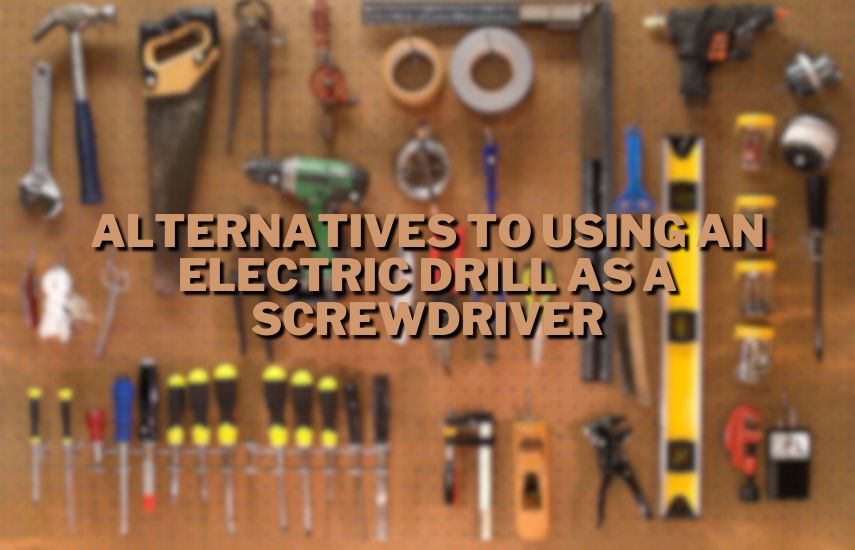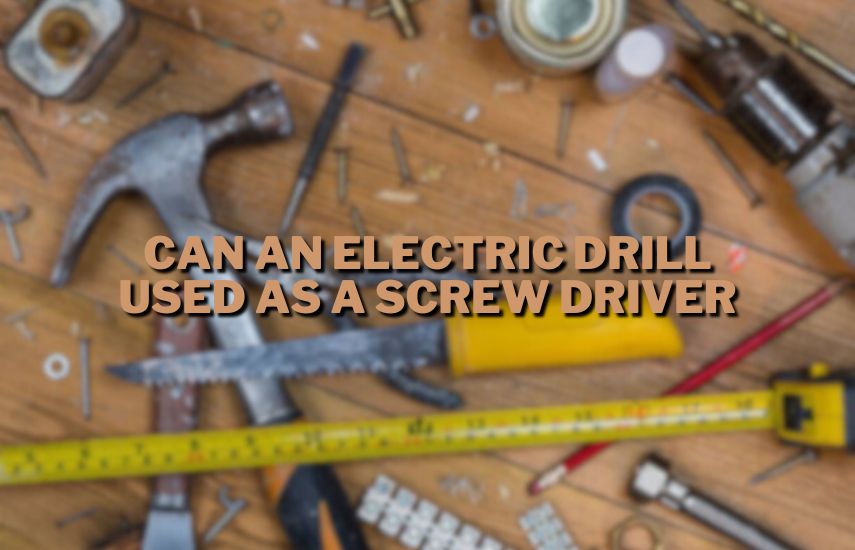Hey there! Have you ever wondered if you can use an electric drill as a screwdriver? Well, you’re in the right place to find out. Many of us have used a screwdriver to tighten or loosen screws, but the idea of using an electric drill for the same job might be new. Electric drills are commonly used for drilling holes in various materials, like wood or metal.
Can An Electric Drill Used As A Screw Driver? You can employ an electric drill as a screwdriver effectively. By connecting a screwdriver bit to the drill’s chuck, you can conveniently drive screws into various materials. Yet, do remember to be mindful of the drill’s torque settings to avert any potential damage to the screw or the material you’re working on. Always prioritize safety and precaution.
But can they handle the task of driving screws too? In this exploration, we’ll dive into whether an electric drill can really replace a screwdriver. We’ll look at the features of both tools and see if an electric drill can do the job effectively. So, let’s dig into the details and figure out if your trusty electric drill can be a versatile tool in your toolbox!
The Basics of Using an Electric Drill as a Screwdriver
Hello there! If you’re looking to make your DIY tasks easier and more efficient, using an electric drill as a screwdriver can be a handy trick to have up your sleeve. Let’s dive into the basics of how to do it.
Choosing the Right Drill Bit
First things first, before you start using your electric drill as a screwdriver, you need to pick the right drill bit. Look for a bit that matches the size of the screw you’re using. A bit that’s too big or too small won’t work well. Also, ensure the bit is a standard one, as specialized bits might not fit in your drill’s chuck properly.
Adjusting the Clutch Settings
Most electric drills come with a clutch, which is like a built-in safety feature. It helps you control the amount of torque or twisting force the drill applies. When using your drill as a screwdriver, it’s essential to adjust the clutch settings. Set it to a lower torque setting to avoid over-tightening the screw, which could damage the material you’re working with.
Inserting the Bit and Screw
Now that you have the right bit and adjusted the clutch, it’s time to insert the bit into the drill’s chuck. Open the chuck by turning it counterclockwise, insert the bit, and then tighten the chuck by turning it clockwise. With the bit in place, you can now insert the screw into the bit’s slot. Make sure the screw sits securely on the bit to prevent wobbling.
Driving the Screw
Here comes the fun part – driving the screw! Place the bit onto the screw head and apply gentle pressure. Start the drill at a slow speed to avoid any sudden jerks. As the screw goes in, you can gradually increase the speed, but don’t go too fast. Let the drill’s torque do the work for you. Keep the drill straight and aligned with the screw to ensure it goes in smoothly.
Removing the Screw
If you ever need to remove a screw, your electric drill can help with that too. Just reverse the drill’s direction by switching the button usually located near the trigger. Place the bit on the screw head, start at a slow speed, and then increase as needed. Once the screw is loosened, you can switch to a manual screwdriver to finish the job and avoid accidentally stripping the screw head.
How to Choose the Right Drill for Screwdriving

If you’re gearing up for some screwdriving action, it’s crucial to have the right drill in your toolbox. Let’s dive into the nitty-gritty of how to pick the perfect drill for your screwdriving needs.
Consider The Drill Type
First things first, you need to choose the right type of drill. For screwdriving, a cordless drill is your best friend. Cordless drills are portable and convenient, allowing you to move around freely without being tethered to an outlet. Look for a drill with adjustable speed settings, as this will give you better control while driving screws.
Mind The Power
The power of your drill matters. Opt for a drill with sufficient power for your screwdriving tasks. A drill with a power rating between 12V and 18V is generally suitable for most home projects. Higher voltage drills offer more power but may not be necessary for basic screwdriving tasks.
Check The Chuck Size
The chuck is the part of the drill that holds the drill bit or screwdriver bit in place. When choosing a drill for screwdriving, consider the chuck size. A 3/8-inch chuck is common and works well for most screwdriving jobs. Make sure the chuck can securely hold the screwdriver bit you plan to use.
Clutch Settings Are Key
The clutch is a crucial feature for screwdriving. It helps prevent over-tightening of screws by disengaging the drill’s motor when a certain torque level is reached. Look for a drill with multiple clutch settings. This way, you can adjust the torque according to the size of the screw and the material you’re working with. It’s like having a built-in safety net for your screws!
Ergonomics and Comfort
Last but not least, don’t overlook the comfort factor. Since you’ll be using the drill for extended periods, it’s important that it feels comfortable in your hand. Opt for a drill with an ergonomic grip and a balanced design. This will help reduce fatigue during long screwdriving sessions.
How to Use an Electric Drill as a Screwdriver Safely
Using an electric drill as a screwdriver can make your projects faster and easier, but safety should always come first. Let’s explore the best ways to use your drill as a screwdriver while keeping safety in mind.
Wear Appropriate Safety Gear
Safety gear is your trusty sidekick. Don’t skip wearing safety glasses to shield your eyes from debris and dust. Depending on the task, gloves can protect your hands, and ear protection can keep your ears comfortable when the drill’s running. Prioritize your safety by suiting up with the right gear.
Select the Right Drill Bit and Screwdriver Bit
Matching the right bits to your task is like finding the right puzzle piece. Choose a drill bit that fits your screw’s size, and make sure your screwdriver bit is snugly fitted onto the drill. A mismatched bit can lead to accidents or stripped screws, which can be frustrating. Double-check and get the right combination!
Mind Your Speed And Pressure
Easy does it! When you start drilling, begin at a slow speed to avoid sudden surprises. Gradually increase the speed as you go. Also, don’t push too hard; let the drill’s weight and torque do the work. Applying excessive force can lead to the screw getting damaged or your drill going off-course.
Adjust the Clutch Setting
The clutch is your safety superhero. It helps control the amount of torque applied. For screwdriving, set the clutch to a lower level to prevent over-tightening. This way, you won’t damage the material or strip the screw head. The right clutch setting ensures your screws are snug without causing harm.
Maintain Proper Posture And Stability
Stability is your drill’s best friend. Stand with your feet shoulder-width apart and maintain a balanced posture. This keeps you steady and in control. Keep your hands away from the drill’s moving parts and the screw head. By staying balanced and vigilant, you’re reducing the risk of accidents.
Alternatives to Using an Electric Drill as a Screwdriver

While using an electric drill as a screwdriver is super handy, there are other options too. Let’s explore some alternatives that might suit your needs and tools.
Manual Screwdrivers: Classic And Reliable
Good old manual screwdrivers are like the timeless heroes of screwdriving. They come in various sizes and types, from Phillips to flathead. With a manual screwdriver, you get precise control and can avoid over-tightening. They’re perfect for small tasks or delicate materials where power drills might be too much.
Cordless Screwdrivers: Compact and Convenient
Cordless screwdrivers are like the pocket-sized version of electric drills. They’re lightweight, easy to maneuver, and great for light to medium tasks. They come with built-in rechargeable batteries and adjustable torque settings. Cordless screwdrivers are perfect for assembling furniture, hanging pictures, or quick fixes.
Hand Impact Drivers: Extra Power for Tough Jobs
Imagine a superhero version of a manual screwdriver – that’s a hand impact driver. It’s designed to give you extra force with less effort. It’s great for stubborn screws or working with rusted fasteners. With a few taps from a hammer, the impact driver’s rotational force helps remove or insert screws effectively.
Ratchet Screwdrivers: Ratcheting Goodness
Ratchet screwdrivers are like the multitasking champs of screwdriving. They have a mechanism that allows you to keep the tool on the screw while turning it, making it quicker and more efficient. They’re handy when you have lots of screws to deal with in one go.
Power Screwdrivers: In-Between Convenience
Power screwdrivers are like a bridge between manual and electric. They’re more powerful than manual screwdrivers but not as robust as electric drills. They often have interchangeable bits and adjustable torque settings. Power screwdrivers are a solid choice for moderate projects where you want a bit of both worlds.
The Future of Electric Drills as Screwdrivers
The world of tools is ever-evolving, and electric drills used as screwdrivers are no exception. Let’s dive into what the future might hold for these versatile tools.
Smart Integration And Connectivity
Imagine your electric drill being in sync with your smartphone or tablet. The future could bring smart integration, where you can control your drill’s speed and torque settings through an app. This would make adjusting your tool even more convenient and precise.
Enhanced Battery Technology
Battery life is a game-changer. As battery technology advances, electric drills might become more energy-efficient and offer longer usage times. Quick-charging features could become standard, reducing downtime during your projects.
Compact Design and Lightweight Materials
As technology progresses, electric drills could become even more compact and lightweight. This would make them easier to handle and maneuver, especially for intricate tasks. Additionally, innovative lightweight materials could contribute to reduced fatigue during extended use.
Advanced Torque Control
Precision could reach new heights with advanced torque control systems. The future might bring even more customizable torque settings, allowing you to fine-tune your drill’s performance based on the specific screw and material you’re working with.
Environmentally Friendly Innovation
The future is green! We might see electric drills designed with sustainability in mind. This could involve using eco-friendly materials, energy-efficient components, and even recycling programs for old tools.
conclusion (Can An Electric Drill Used As A Screw Driver)
An electric drill can be used as a screwdriver. By attaching a screwdriver bit to the drill’s chuck, you can drive screws quickly and efficiently. Adjust the clutch settings for proper torque control, and you’re good to go. Just remember to start with a low speed and prioritize safety while working.
Using an electric drill as a screwdriver is a practical and efficient solution for various DIY tasks. It offers speed and convenience, making screwdriving less labor-intensive. By choosing the right drill bits, adjusting clutch settings, and maintaining proper safety precautions, you can successfully drive screws without the need for manual effort.
While an electric drill might not replace traditional screwdrivers entirely, it provides a valuable alternative that saves time and effort, especially for larger projects. Just remember to use it wisely, keeping safety in mind, to make your DIY ventures smoother and more enjoyable.









